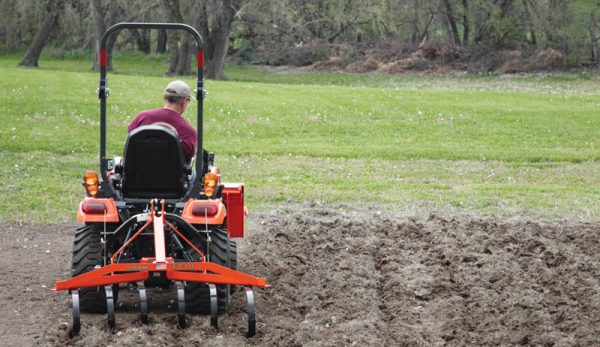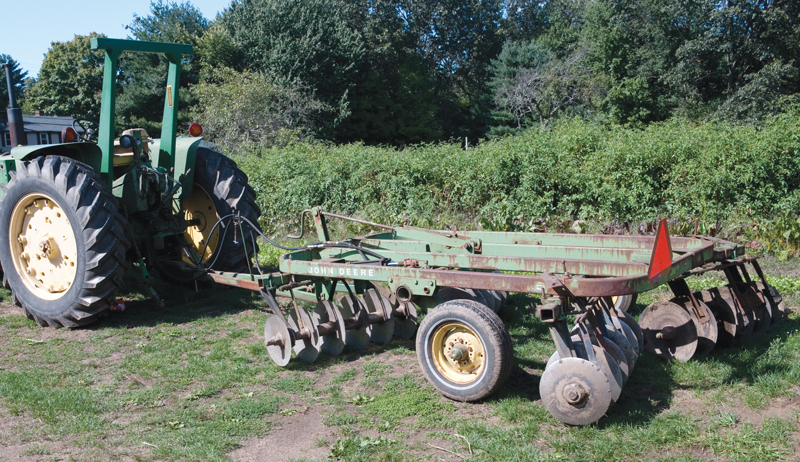
If you own a compact tractor, you have many ways to loosen the dirt and prepare your land for a garden, lawn seed or wildflower plots. Tilling the soil is essential for numerous reasons including aeration, breaking up blocky soil to increase soil-to-seed contact and weed control. But which tillage tools are best for you?
I’ve tested them all and here is my rundown on how each tool works and the scenario in which it works best.
Field Cultivator
A field cultivator is a versatile tool that often has spring steel tines and replaceable and referable tips. The ability to reverse the tips on the straight-shanked cultivator tips extends the life of the tips. When one end begins to wear out, just flip the tip and use the other end.
Many models let you adjust the spacing of the tines for precise applications.
I use a field cultivator for several functions. You can set the spacing on the tines to skip the middle row while the rest of the tines plow between the rams for weed control. In addition, when breaking out ground that’s lain fallow for a while, I use the field cultivator for a quick once-over on the ground.

Disk Harrow
The disk harrow, often referred to as simply a disk plow, is probably the most common and most versatile tillage tool. Found in almost every compact tractor implement lot, the disk plow is used as a primary and finish tillage tool.
The tandem disk harrow has two gangs of disks that cut in opposite directions. They chop big blocks of soil into finer pieces that are perfect for planting.
Some disk harrows feature plain, round disks on front and rear gangs. Other models have notched disks on the front for aggressive digging and round disks on the back to create a smooth, fine seedbed.
I use the disk for medium-duty uses when I need to prolapse a seedbed quickly. Because it’s three-point mounted and a fairly compact piece of equipment, it works well for getting in tight, woodland spaces for prepping ground for wildlife food plots.
In addition, I’ll use the disk to lightly plow my yard when I need to overseed the lawn with new grass seed. Finally, the disk harrow is a great go-to tool for simply garden preparation.
Read more: Info overload? Here’s a quick primer for equipment names to keep you in the know.
Tiller
My tiller is probably my favorite piece of equipment. Because it runs on the tractor’s PTO, the tiller is a powerful tool for prepping seedbeds. It incorporates organic matter into the soil and serves myriad other uses.
Aside from seedbed prep, I use the tiller to till over ruts to smooth out roads or to smooth out fence lines to create a flat path in which to lay a fence. Each spring, after my kids’ show-pigs leave the farm, I use the tiller to help break up the compacted soil. I fill in the wallows and mix the pig manure back into the soil.
When I’m done, the soil is ultra-fine and ready for overseeding.

Moldboard Plow
A moldboard plow is a primary tillage tool that’s often used for the first plowing of new ground. Deep-dished plows dig aggressively into the soil and turn over big chunks of soil in a single pass. It’s a great tool for breaking up hardpan soil and integrating heavy organic matter into the soil.
The moldboard, however, takes a lot of power. That’s why you can buy a one- or two-bottom moldboard plow.
The moldboard is designed for first-time tillage. So you need to run back over the plowed ground with a disk harrow to help break up the big clods and further prepare the soil for planting.
Read more: These 5 seasonal tractor maintenance tasks will keep your machine in tip-top shape.
Rippers
Rippers aren’t made so much for plowing as they are for conditioning over-plowed soil. The term “hardpan” refers to subsoil packed by multiple tillage passes over the same ground.
Hardpan reduces water infiltration and inhibits root growth. A good management plan is to use rippers or a moldboard every few seasons. (You can rip more often depending on the makeup of your top and subsoil.) This breaks up the hardpan to ensure healthy soil.
As with a moldboard, you can buy a one- or two-shank ripper that helps you manage your tractor’s horsepower more efficiently.
One last note: Rippers work great on the subsurface. But you still need to do some finish plowing on the top soil to prepare the beds for planting.




